�
Use R!
Advisors:
Robert Gentleman· Kurt Hornik· Giovanni Parmigiani
Use R!
Albert: Bayesian Computation with R
Bivand/Pebesma/G´omez-Rubio: Applied Spatial Data Analysis with R
Claude: Morphometrics with R
Cook/Swayne: Interactive and Dynamic Graphics for Data Analysis: With R and
GGobi
Hahne/Huber/Gentleman/Falcon: Bioconductor Case Studies
Kleiber/Zeileis, Applied Econometrics with R
Nason: Wavelet Methods in Statistics with R
Paradis: Analysis of Phylogenetics and Evolution with R
Peng/Dominici: Statistical Methods for Environmental Epidemiology with R: A
Case Study in Air Pollution and Health
Pfaff: Analysis of Integrated and Cointegrated Time Series with R, 2nd edition
Sarkar: Lattice: Multivariate Data Visualization with R
Spector: Data Manipulation with R
�
Christian Kleiber · Achim Zeileis
Applied Econometrics with R
123
�
Christian Kleiber
Universit¨at Basel
WWZ, Department of Statistics and Econometrics
Petersgraben 51
CH-4051 Basel
Switzerland
Christian.Kleiber@unibas.ch
Achim Zeileis
Wirtschaftsuniversit¨at Wien
Department of Statistics and Mathematics
Augasse 2–6
A-1090 Wien
Austria
Achim.Zeileis@wu-wien.ac.at
Kurt Hornik
Department of Statistics and Mathematics
Wirtschaftsuniversit¨at Wien
Augasse 2–6
A-1090 Wien
Austria
Series Editors
Robert Gentleman
Program in Computational Biology
Division of Public Health Sciences
Fred Hutchinson Cancer Research Center
1100 Fairview Avenue N., M2-B876
PO Box 19024, Seattle, Washington 98102-1024
USA
Giovanni Parmigiani
The Sidney Kimmel Comprehensive Cancer Center
at Johns Hopkins University
550 North Broadway
Baltimore, MD 21205-2011
USA
ISBN: 978-0-387-77316-2
DOI: 10.1007/978-0-387-77318-6
e-ISBN: 978-0-387-77318-6
Library of Congress Control Number: 2008934356
c 2008 Springer Science+Business Media, LLC
All rights reserved. This work may not be translated or copied in whole or in part without the written permission of the
publisher (Springer Science+Business Media, LLC, 233 Spring Street, New York, NY 10013, USA), except for brief
excerpts in connection with reviews or scholarly analysis. Use in connection with any form of information storage and
retrieval, electronic adaptation, computer software, or by similar or dissimilar methodology now known or hereafter
developed is forbidden.
The use in this publication of trade names, trademarks, service marks, and similar terms, even if they are not identified
as such, is not to be taken as an expression of opinion as to whether or not they are subject to proprietary rights.
Printed on acid-free paper
springer.com
�
Preface
R is a language and environment for data analysis and graphics. It may be
considered an implementation of S, an award-winning language initially de-
veloped at Bell Laboratories since the late 1970s. The R project was initiated
by Robert Gentleman and Ross Ihaka at the University of Auckland, New
Zealand, in the early 1990s, and has been developed by an international team
since mid-1997.
Historically, econometricians have favored other computing environments,
some of which have fallen by the wayside, and also a variety of packages with
canned routines. We believe that R has great potential in econometrics, both
for research and for teaching. There are at least three reasons for this: (1) R
is mostly platform independent and runs on Microsoft Windows, the Mac
family of operating systems, and various flavors of Unix/Linux, and also on
some more exotic platforms. (2) R is free software that can be downloaded
and installed at no cost from a family of mirror sites around the globe, the
Comprehensive R Archive Network (CRAN); hence students can easily install
it on their own machines. (3) R is open-source software, so that the full source
code is available and can be inspected to understand what it really does,
learn from it, and modify and extend it. We also like to think that platform
independence and the open-source philosophy make R an ideal environment
for reproducible econometric research.
This book provides an introduction to econometric computing with R; it is
not an econometrics textbook. Preferably readers have taken an introductory
econometrics course before but not necessarily one that makes heavy use of
matrices. However, we do assume that readers are somewhat familiar with ma-
trix notation, specifically matrix representations of regression models. Thus,
we hope the book might be suitable as a “second book” for a course with
sufficient emphasis on applications and practical issues at the intermediate
or beginning graduate level. It is hoped that it will also be useful to profes-
sional economists and econometricians who wish to learn R. We cover linear
regression models for cross-section and time series data as well as the com-
mon nonlinear models of microeconometrics, such as logit, probit, and tobit
�
vi
Preface
models, as well as regression models for count data. In addition, we provide
a chapter on programming, including simulations, optimization, and an in-
troduction to Sweave()—an environment that allows integration of text and
code in a single document, thereby greatly facilitating reproducible research.
(In fact, the entire book was written using Sweave() technology.)
We feel that students should be introduced to challenging data sets as
early as possible. We therefore use a number of data sets from the data
archives of leading applied econometrics journals such as the Journal of Ap-
plied Econometrics and the Journal of Business & Economic Statistics. Some
of these have been used in recent textbooks, among them Baltagi (2002),
Davidson and MacKinnon (2004), Greene (2003), Stock and Watson (2007),
and Verbeek (2004). In addition, we provide all further data sets from Bal-
tagi (2002), Franses (1998), Greene (2003), and Stock and Watson (2007),
as well as selected data sets from additional sources, in an R package called
AER that accompanies this book. It is available from the CRAN servers at
http://CRAN.R-project.org/ and also contains all the code used in the fol-
lowing chapters. These data sets are suitable for illustrating a wide variety of
topics, among them wage equations, growth regressions, dynamic regressions
and time series models, hedonic regressions, the demand for health care, or
labor force participation, to mention a few.
In our view, applied econometrics suffers from an underuse of graphics—
one of the strengths of the R system for statistical computing and graphics.
Therefore, we decided to make liberal use of graphical displays throughout,
some of which are perhaps not well known.
The publisher asked for a compact treatment; however, the fact that R has
been mainly developed by statisticians forces us to briefly discuss a number
of statistical concepts that are not widely used among econometricians, for
historical reasons, including factors and generalized linear models, the latter
in connection with microeconometrics. We also provide a chapter on R basics
(notably data structures, graphics, and basic aspects of programming) to keep
the book self-contained.
The production of the book
The entire book was typeset by the authors using LATEX and R’s Sweave()
tools. Specifically, the final manuscript was compiled using R version 2.7.0,
AER version 0.9-0, and the most current version (as of 2008-05-28) of all other
CRAN packages that AER depends on (or suggests). The first author started
under Microsoft Windows XP Pro, but thanks to a case of theft he switched
to Mac OS X along the way. The second author used Debian GNU/Linux
throughout. Thus, we can confidently assert that the book is fully repro-
ducible, for the version given above, on the most important (single-user) plat-
forms.
�
Preface
vii
Settings and appearance
R is mainly run at its default settings; however, we found it convenient to
employ a few minor modifications invoked by
R> options(prompt="R> ", digits=4, show.signif.stars=FALSE)
This replaces the standard R prompt > by the more evocative R>. For compact-
ness, digits = 4 reduces the number of digits shown when printing numbers
from the default of 7. Note that this does not reduce the precision with which
these numbers are internally processed and stored. In addition, R by default
displays one to three stars to indicate the significance of p values in model sum-
maries at conventional levels. This is disabled by setting show.signif.stars
= FALSE.
Typographical conventions
We use a typewriter font for all code; additionally, function names are fol-
lowed by parentheses, as in plot(), and class names (a concept that is ex-
plained in Chapters 1 and 2) are displayed as in “lm”. Furthermore, boldface
is used for package names, as in AER.
Acknowledgments
This book would not exist without R itself, and thus we thank the R Develop-
ment Core Team for their continuing efforts to provide an outstanding piece
of open-source software, as well as all the R users and developers supporting
these efforts. In particular, we are indebted to all those R package authors
whose packages we employ in the course of this book.
Several anonymous reviewers provided valuable feedback on earlier drafts.
In addition, we are grateful to Rob J. Hyndman, Roger Koenker, and Jeffrey
S. Racine for particularly detailed comments and helpful discussions. On the
technical side, we are indebted to Torsten Hothorn and Uwe Ligges for advice
on and infrastructure for automated production of the book. Regarding the
accompanying package AER, we are grateful to Badi H. Baltagi, Philip Hans
Franses, William H. Greene, James H. Stock, and Mark W. Watson for per-
mitting us to include all the data sets from their textbooks (namely Baltagi
2002; Franses 1998; Greene 2003; Stock and Watson 2007). We also thank
Inga Diedenhofen and Markus Hertrich for preparing some of these data in
R format. Finally, we thank John Kimmel, our editor at Springer, for his pa-
tience and encouragement in guiding the preparation and production of this
book. Needless to say, we are responsible for the remaining shortcomings.
May, 2008
Christian Kleiber, Basel
Achim Zeileis, Wien
�
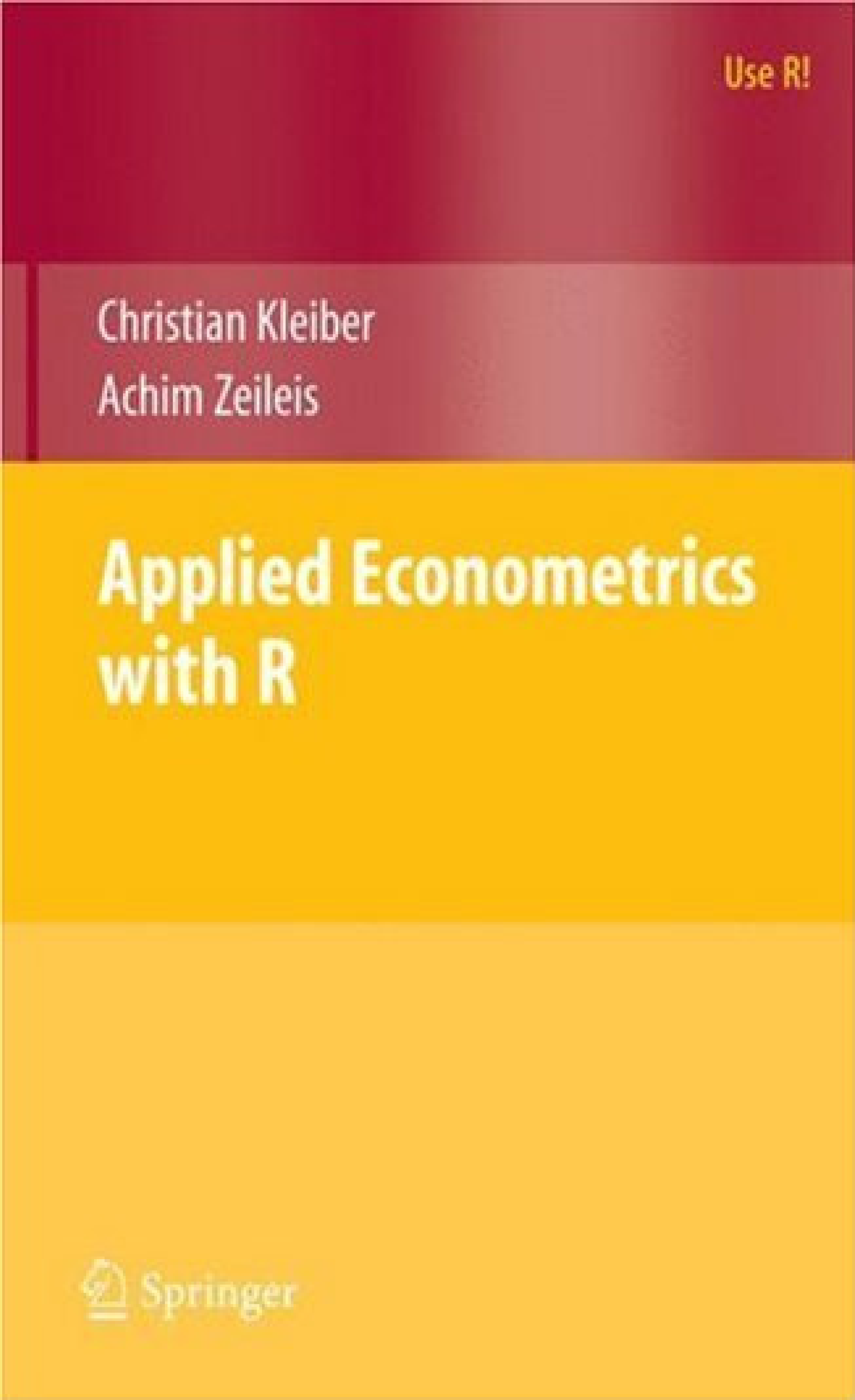

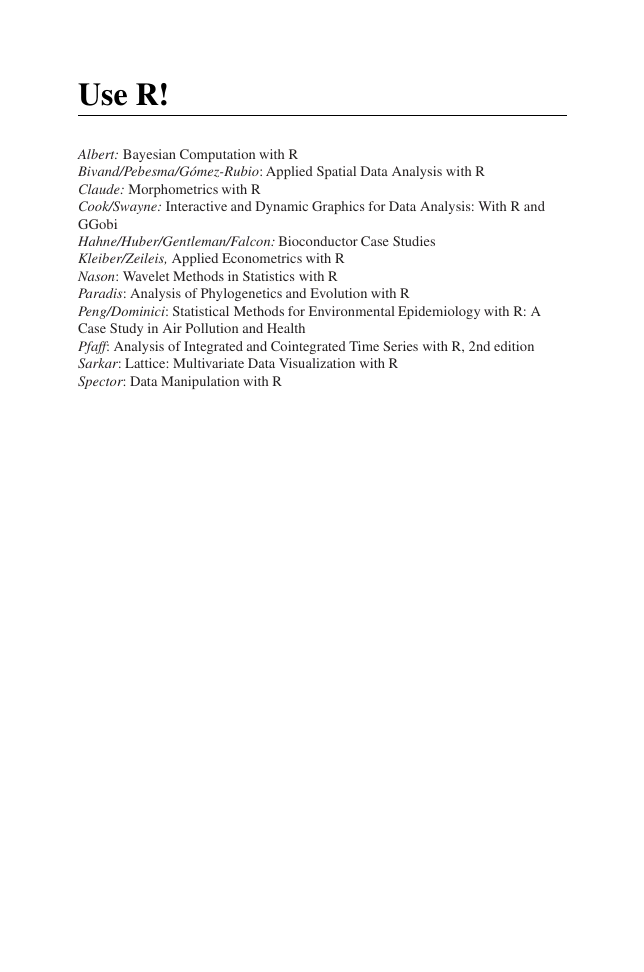
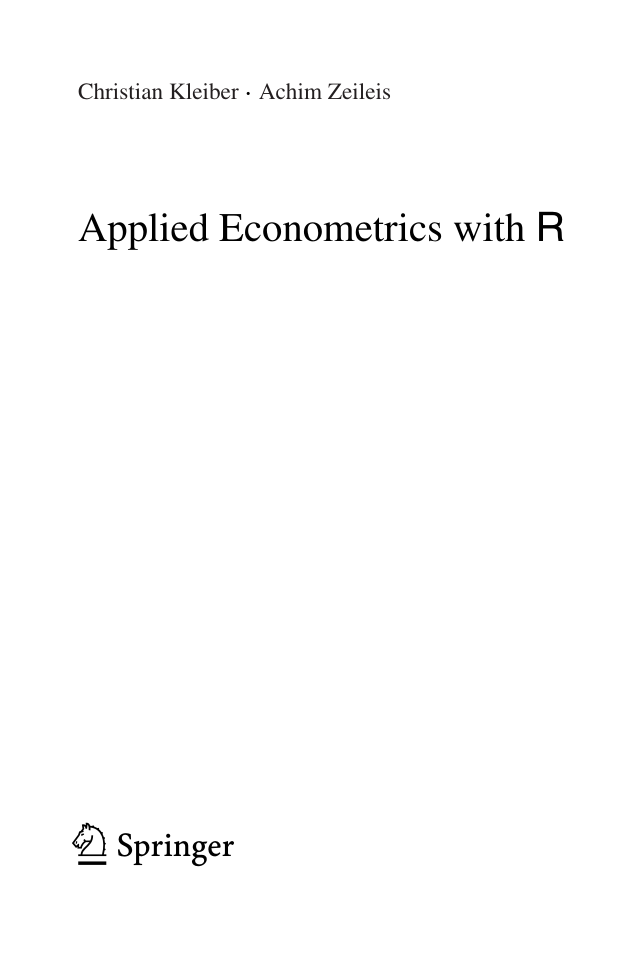

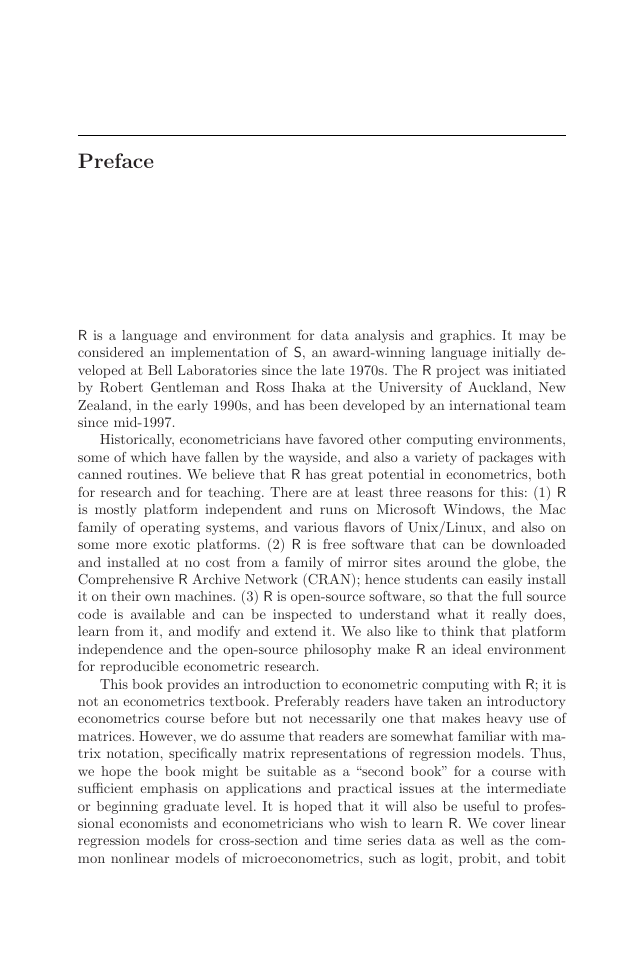

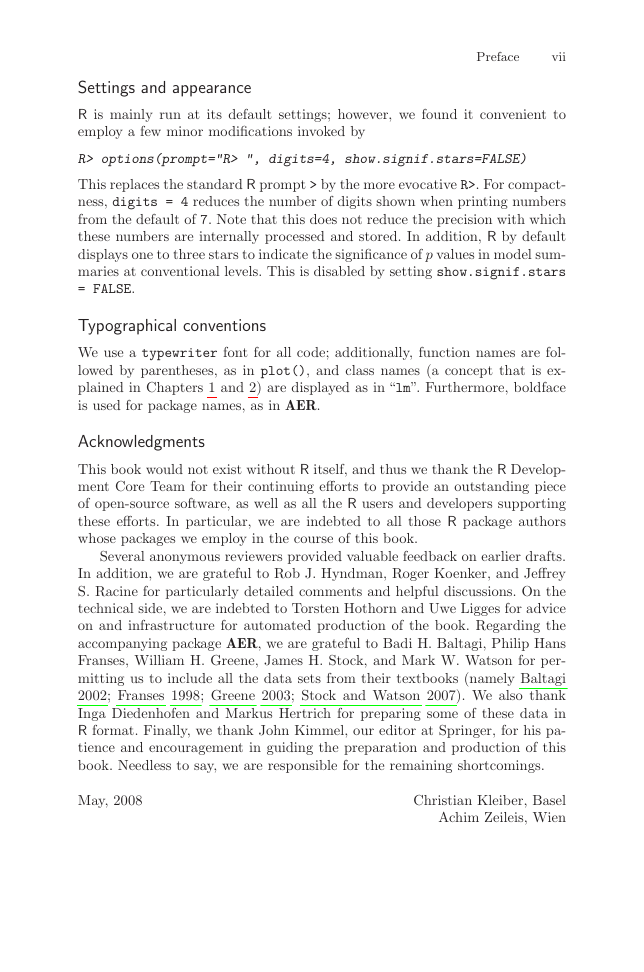








 2023年江西萍乡中考道德与法治真题及答案.doc
2023年江西萍乡中考道德与法治真题及答案.doc 2012年重庆南川中考生物真题及答案.doc
2012年重庆南川中考生物真题及答案.doc 2013年江西师范大学地理学综合及文艺理论基础考研真题.doc
2013年江西师范大学地理学综合及文艺理论基础考研真题.doc 2020年四川甘孜小升初语文真题及答案I卷.doc
2020年四川甘孜小升初语文真题及答案I卷.doc 2020年注册岩土工程师专业基础考试真题及答案.doc
2020年注册岩土工程师专业基础考试真题及答案.doc 2023-2024学年福建省厦门市九年级上学期数学月考试题及答案.doc
2023-2024学年福建省厦门市九年级上学期数学月考试题及答案.doc 2021-2022学年辽宁省沈阳市大东区九年级上学期语文期末试题及答案.doc
2021-2022学年辽宁省沈阳市大东区九年级上学期语文期末试题及答案.doc 2022-2023学年北京东城区初三第一学期物理期末试卷及答案.doc
2022-2023学年北京东城区初三第一学期物理期末试卷及答案.doc 2018上半年江西教师资格初中地理学科知识与教学能力真题及答案.doc
2018上半年江西教师资格初中地理学科知识与教学能力真题及答案.doc 2012年河北国家公务员申论考试真题及答案-省级.doc
2012年河北国家公务员申论考试真题及答案-省级.doc 2020-2021学年江苏省扬州市江都区邵樊片九年级上学期数学第一次质量检测试题及答案.doc
2020-2021学年江苏省扬州市江都区邵樊片九年级上学期数学第一次质量检测试题及答案.doc 2022下半年黑龙江教师资格证中学综合素质真题及答案.doc
2022下半年黑龙江教师资格证中学综合素质真题及答案.doc